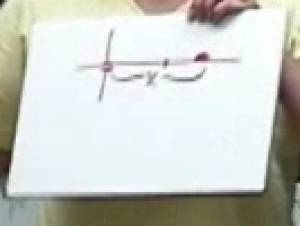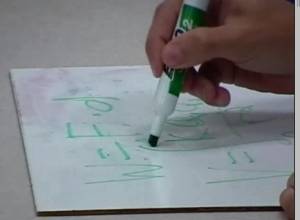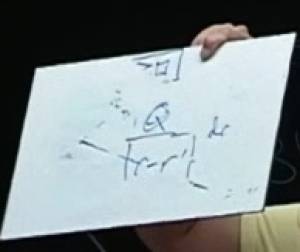Examples of Spontaneous Use of Small White Boards
Physics Paradigms Physics 320, Thursday, September 27, 2007
Day 4 of Week 1
By Emily van Zee and Corinne Manogue
This interpretative narrative is based upon a video of the class session and discussions with the instructor and the director of the Physics Paradigms Program, Corinne Manogue. In writing the narrative, Emily van Zee drew upon her research in the tradition of ethnography of communication (Hymes, 1972; Philipsen & Coutu, 2004; van Zee & Minstrell, 1997a,b), a discipline that studies cultures through the language phenomena observed. This interpretative narrative presents an example of an instructor engaging students as novice participants in the culture of “thinking like a physicist.”
This short narrative provides several examples of spontaneous use of small white boards. These examples occurred during a discussion that the instructor had initiated with a planned small white board question. A longer narrative presents the details of both the physics and the pedagogy that this planned small white board question had elicited. This discussion occurred on Thursday, September 27, 2007.
When students enter this classroom, each picks up a small white board (about 30 x 40 cm), marker, and cloth to use as an eraser. When the instructor asks a small white board question, the students write their answers on these small white boards. Sometimes they just hold up their boards so that the instructor can see the array of responses and make a quick assessment of the level of knowledge present in the group.
Sometimes, however, the instructor moves around the room as the students are writing on their small white boards. As the students finish, the instructor picks up examples representing various issues needing attention and places these, with writing facing away from the students, in a particular order along the chalk tray of the blackboard at the front of the room. The responses written on each of these selected small white boards then form the basis for the subsequent discussion.
During a discussion, the instructor also sometimes asks individual students to write on their small white boards as a way to help them communicate their ideas. Occasionally a student will spontaneously write on a small white board to clarify a question the student wants to ask. Sometimes students will change what they have written on their whiteboards in response to something said during the discussion. These more spontaneous uses of the small whiteboards are the focus of this short narrative.
This discussion occurred during the first week of the academic year, when the instructor was still establishing how students should think and behave now that they had reached upper level courses as physics majors. There were 21 students in this class, including two women. For details of the physics discussed and pedagogy evident in this discussion, please see the longer narrative for this date.
Both interpretative narratives are based upon a transcript of the small white board discussion and upon reflections recorded by the instructor, Corinne Manogue, and her colleagues, Liz Gire, a postdoc, and Kerry Brown, a graduate of the program, while viewing a video of this session. The narrative was drafted by Emily van Zee, a science teacher educator who drew upon her own teaching experiences in laboratory-centered physics courses for prospective teachers and her research in the tradition of ethnography of communication (Hymes, 1972; Philipsen & Coutu, 2004; van Zee & Minstrell, 1997a,b). Ethnographers of communication examine cultural practices by interpreting what is said, where, when, by whom, for what purpose, in what way, and in what context. These interpretative narratives present an example of an instructor initiating students into the culture of physics, specifically into the verbal and mathematical language that physicists use in thinking and talking about the focus of this discussion: the electrostatic potential at a location in space due to a point charge.
Using a White Board to Clarify a Student’s Thinking [01:07:35.01] - [01:09:36.07]
The short narrative presents what had happened when Corinne had asked the class to write on their small white boards an expression for the electrostatic potential at a particular location in space due to a point charge. She had collected a representative set of the students’ responses and then discussed these. Several times during that discussion, she spontaneously asked students to write what they were thinking on their small white boards so that she and the other students could understand better what they were trying to say. For example, a student offered an analogy as a way to think about potentials:
Student: Way I think about it is to relate the electric potential to the gravitational potential because they're pretty much the same thing, the force equation is the same, so you do like force over, force times the distance? I mean that’s work
Corinne asked him to write the equation on his small white board to assist him in communicating his thinking both to her and to the other students:
Corinne: Write me down your equation so I can hold it up
The student wrote $W = F\cdot d$ and then $V = \int K Q_1 Q_d/r^2$ from 0 to $d$
Corinne reached for the white board, moved away, and then returned the board to the student who added dr to complete the integral expression. Corinne then took back the white board and addressed the class:
Corinne: Ok (name) is claiming that you can use the gravitational analog, and for some peculiar reason many students are much better at reasoning about the gravitational case than reasoning about the electrostatic case and you are absolutely right, except for an overall constant that has units in it, and a very important, physically important sign, all of the mathematics for gravitational fields is the same as the mathematics for electrostatic fields so if you can do it for a gravitational field and that makes sense to you, use that analogy. Let it help you! All right.
Corinne then held the small white board up for all to see:
Corinne: (Name)'s claim is work is force times distance. All right. And then the potential is the integral of the force times the distance but I think that's a variant of this.
Corinne reached for and held up the white board with $V = \int E\cdot ds$ that had been discussed earlier.
Corinne: Since if there's only one thing in the universe, we can't yet be talking about forces, so there's good reasoning and good memory there going on but not what we need for this problem.
By welcoming the student’s suggestion, prompting him to write out his idea on his small white board, holding up the board for the rest of the class to see, and discussing its contents, Corinne had used a student’s writing on a small white board in the midst of the discussion to help communicate the student’s thinking to the rest of the class. Although the physics was not appropriate - his suggestion referred to forces, which could not occur with only one charge in the universe - she took care to complement the thinking - his reasoning and effort to pull relevant information from his memory.
Example of Using a Small White Board to Clarify a Student’s Question [01:15:25.12]- [01:17:14.02]
After the class had come to agreement on an appropriate expression for the electrostatic potential due to a point charge, $V= k Q/r$, Corrine initiated a discussion about the meaning of $r$, what distance was it representing? Speaking with hesitation expressed as a question, a student offered a more nuanced expression for the distance between the charge and the probe:
Student: $r$ minus $r$ naught?
Corinne: What about $r$ minus $r$ naught?
Student: The distance between there and there
Corinne: Write me something on your white board. I don't know what $r$ minus $r$ naught means.
Corinne and the class waited and watched while the student wrote his expression on his small white board. Then she held it up for all to see:
While viewing this segment of the video, Liz commented about this use of the small white boards, that Corinne was asking individual students to write mathematical expressions on the small white boards so that the students could communicate more clearly with Corinne and so that Corinne could use the white board to communicate their shared meaning to the rest of the class. Not only can an instructor ask small white board questions to the entire class but one can also ask them of individuals to help clarify their meanings.
Corinne agreed that when a student asks about a formula, she and the student can communicate much more clearly if the student writes the formula on a small white board. She noted that this is what professionals do when talking with each other, they write on napkins or backs of envelopes or whatever board is nearby to be sure that they understand and agree on the formula that they’re discussing.
Corinne: Ah. Ok! He's trying to write a magnitude of $r$ minus $r$ naught. So where is $r$ and where is $r$ naught?
Student: $r$ naught is at the origin
Corinne: Where is the origin?
The student pointed at a representation of a coordinate system, the three dowel rods connected at right angles, that was sitting on a table in front of Corinne.
Student: That.
Corinne put down the student’s white board and while still holding up the ball representing the charge, held up the coordinate system so all could see it. She then put both the ball and the coordinate system down together on the table.
Corinne: Ok. So I'm going to put this charge at the origin.
Imagine it's in the center. All right. And then?
Corinne picked up the student’s white board again and held it up for the students to see.
Student: The $r$ is wherever you’re thinking about at the moment
Corinne walked back to the table and picked up the probe and held it high for all to see:
Student: wherever that is
Corinne: Ok. All right. If I put the charge at the origin, then what does that tell you about this?
She pointed at the $r$ in $r – r’$ on the student’s white board:
Students: $r$ naught is zero
Corinne: Then it's just zero. What kind of a zero? It's a zero vector. All right. So the zero vector minus $r$ prime is just the vector from the origin (points to coordinate system on the table) to here (picks up probe).
In discussing this video, Corinne noted that in a discussion in which she was trying to help the students understand which is $\vec r$ and which is $\vec r'$, that she had mixed it up herself. So the words “zero vector minus $r$ prime” should have been “the zero vector minus $r$.” Fortunately the rest of the discussion was correct and she hopes she did not confuse anybody too much.
So yes indeed, if I put this charge at the origin (points to coordinate system), then this r here (points to white board with correct formula $V = Q/4πε_0 r$) is just the distance from here (ball representing charge) to here (voltmeter probe), the distance from here to here.
In viewing this segment of the video, Corinne commented that she was trying to get the students to see the difference between scalars and vectors and by manipulating the physical things, trying to get them to focus on the geometry.
Example of a Student’s Spontaneous Correction of His Own Small White Board [webcam 1:26-1:27; 1:42-1:43]
During this conversation about r minus r naught, a webcam videoing group 6 shows a student sitting quietly until Corinne says “write on your white board” to the student with whom she is conversing about r minus r naught. The student shown on Webcam 6 turns to his white board in response even though the comment was not directed to him.
Visible in the video was the student’s initial response on his white board to Corinne’s planned small white board question, what is the electro potential due to a point charge? When Corinne initially posed this question, the student had drawn a circle, put a question mark in the circle, drawn an arrow pointing to the circle, and after a long pause while thinking, finally written $kQ/r^2$. He also added some words (that cannot be discerned on the video.) Throughout the long discussion of the various student responses that Corinne had facilitated, he had not changed anything on his small white board.
However, now in response to Corinne’s direction to another student “write on your white board,” this student took his cloth eraser and carefully erased the 2 from the $r$ squared. Then he also revised his drawing by extending the line to the center of the circle and labeling the line r.
This spontaneous correction by a student on what he had written earlier on the small white board illustrates another advantage of these devices, that they can provide a prominent visual image of the focus of a discussion for each student, one that the student can revise later as needed.
Considering a Student’s Spontaneous Use of a Small White Board to Contribute an Idea to the Discussion [01:18:50.11] -
After establishing the meaning of r in the formula for the electrostatic potential due to a single point charge, Corinne had introduced a second charge. How could one represent the electrostatic potential at a particular location due to two point charges? In the midst of this discussion, Corinne paused. In the video she can be seen bending forward to look at what one of the students was writing and drawing on her small white board at a table nearby. Meanwhile another student responded verbally:
Student A: Magnitude of the difference between the vectors
Corinne: Magnitude of the difference between the vectors
The student writing and drawing then held up her small white board to show Corinne.
Student B: (Could have one at the origin)
Corinne. I could have one at the origin
Corinne took the white board and showed it to the class.
Corinne: All right. So you want me, You're going to make me work really hard for this answer 
Corinne accepted this student’s offer of an arrangement that would be useful under certain conditions, used the dowels representing the coordinate system to make the suggestive vivid, and then articulated those constraints.
Corinne: So if you're really clever, you can put one at the origin and you can put the other one along the $x$ axis (picks up coordinate system)
Right? So then you can just use a scalar distance there (points to board)
But do I have to put my probe also on the $x$ axis somewhere between them?
Student B: Well I
Corinne: What if I want to measure up here? (holds probe up high) Another student explained the situation if there were only one charge:
Student C: If you're working in a three dimensional space, it creates a potential around itself. So if you go out from it at any radius in 3-D, you get the same potential.
Corinne accepted her suggestion also, made it vivid by holding up the probe to represent measuring the potential anywhere in space around the charge, and then articulated the constraints in system with more than one charge.
Corinne: Right. If I go out anywhere around this one (holds up probe) the same radius, I get the same potential. Absolutely.
But as I go probing around here (moves probe around) and I'm getting the same potential from this one (points to ball), I'm not staying the same radius from that one (points to basketball) Corinne: So all I want is the mathematics of how I describe the distance between here (probe) and here (ball on table).
Another student contributed a thought:
Student D: The magnitude of the distance (?)
Corinne: Exactly. It's the Star Trek example.
A student’s spontaneous and unexpected contribution prompted this interaction among the instructor and several students. The student had used the resource of a small white board to express what she was thinking by sketching a diagram, the sketch made her thinking visually available to the instructor who leaned over to see what the student was drawing, the student was able to offer her thinking via the small white board to the instructor who then was able to convey and discuss the student’s ideas with the whole group; several members of the whole group then contributed to the conversation, and made explicit the connection between the current discussion and the activity in which the students had participated earlier in the session.

